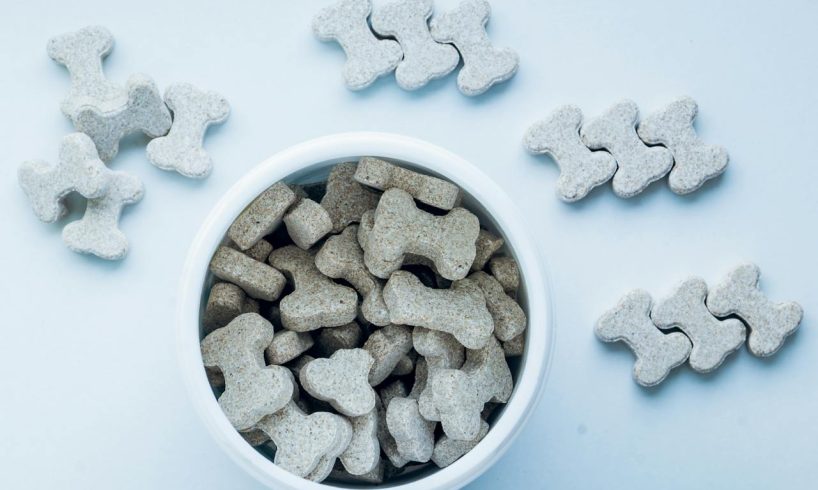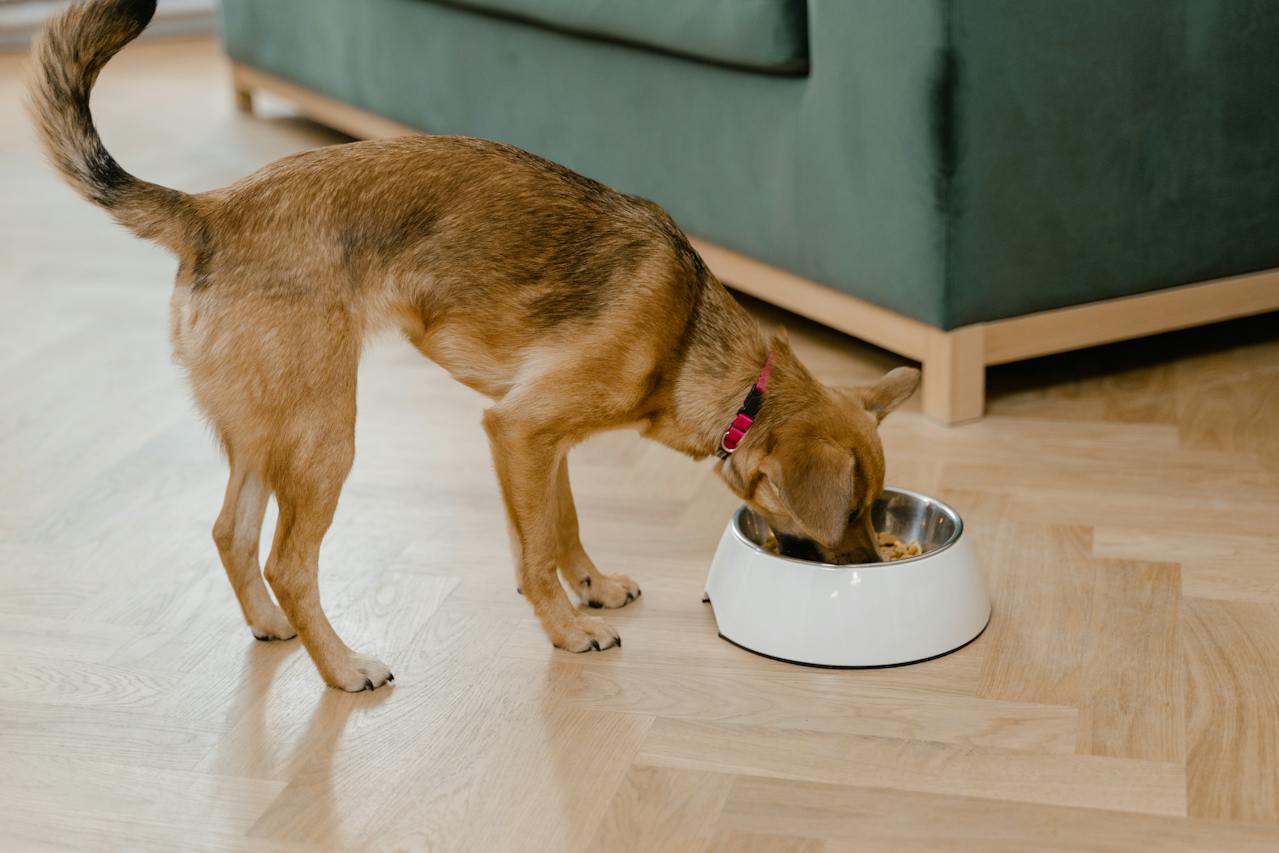
Accurate food measurement is a vital step to helping your dog maintain healthy weight and manage their diet. Using a measuring cup or kitchen scale is more precise than simply counting scoops or eyeballing the amount of food in a bowl.
Overfeeding can lead to obesity, which contributes to a variety of health issues; while underfeeding can cause malnutrition.
1. Use a Measuring Cup
For many pet parents, the simplest way to dole out your dog or cat’s food is with a measuring cup. You may also use a coffee or other standard household cup or even just eyeball it, but using a measuring tool will help you be more deliberate about your pet’s portion size and prevent overfeeding, which is expensive for you and your pet.
Measuring your dog’s food also allows you to keep track of their daily intake, which will allow you to monitor their weight, their overall health and well-being, and any digestive issues they may be experiencing. It will also give you the ability to see if their diet needs to be adjusted to meet their unique dietary requirements.
You can get a set of cups that are specifically designed for pet food to make this process easier or you can simply find a standard measuring cup with measurements labeled on the side. A kitchen scale is another option for those who are looking for more precise measurements. The scale will allow you to weigh the empty cup and then add in your dog’s kibble. This will give you a precise measurement in grams which can be more useful for those with specific dietary needs or who want to avoid overfeeding.
When you first start using a measuring tool or any other method of doling out your pet’s food, it is important to monitor their body condition score (BCS) on a regular basis so you can be sure that they are not under or overfeeding. It is a good idea to work with your veterinarian, who can assess their condition by sight and feel and provide you with a guideline for how much they should be eating.
Once you have established a base guideline for your pet’s feeding, you should then continue to monitor their BCS, energy levels, and coat condition. It is also a good idea to have any medical conditions monitored by your vet and have them adjust the feeding guidelines as needed. With some patience and practice, you will be able to find the feeding method that works best for your pet and their unique needs.
2. Use a Kitchen Scale
For pet owners who are serious about their furry family members’ health and well-being, a kitchen scale is the ultimate tool for measuring dog food portions accurately. While many people may think that busting out the scale is excessive or obsessive, it is one of the best ways to ensure a balanced diet and avoid overfeeding.
A scale allows you to measure food by weight rather than volume, providing more precise measurements. In addition, most digital scales have multiple functions that can help you get the most out of your investment. Some even have a special feature that helps you keep track of your pet’s weight over time, which is an important factor in adjusting their food portion size.
Another benefit of using a scale is that it is more accurate than other measuring methods, including measuring cups. Studies show that using a cup to measure dry food can result in over-estimation of the amount of food being fed, particularly for smaller pets. This can lead to them eating too much and becoming overweight, which has been linked to a host of health problems, including arthritis, diabetes, kidney disease, bladder/urinary tract issues, heart disease, liver disease, and more.
When shopping for a scale, look for a model that is able to display measurements in both grams and ounces, which are the most common units of measurement used for food. Then, choose a scale that has a high weight capacity to accommodate the amount of food your dog consumes each day.
Once you have a good idea of your pet’s ideal weight, you can use the information provided by your veterinarian or the recommended feeding amounts found in the table for their breed. However, remember that every dog is different and should be evaluated by a veterinarian to determine their body condition score (BCS). This visual evaluation considers factors like rib coverage, waistline definition, and muscle tone to assess whether a dog is at an optimal or unhealthy weight.
The most important step in determining your pet’s correct food portion is to monitor their weight and body condition score regularly. If you notice any significant changes, talk with your vet to determine if a change in dog food portion size is necessary.

3. Use a Portion Control Device
Whether you use back-of-the-napkin math, an online calorie calculator or a visit to your veterinarian for guidance on your pet’s diet, accurate portion sizes are essential for your dog’s long-term health and well-being. Too much food can lead to obesity, which is linked with a host of serious ailments including arthritis, heart disease, bladder/urinary tract problems and diabetes. And too little food can cause nutritional deficiencies, which may lead to poor coat condition and other physical problems.
Measuring your pet’s portions is simple with tools like standard measuring cups, kitchen scales and portion control devices that are specifically designed for kibble or homemade food. Each offers unique benefits that help you get the most out of your dog’s meal.
Start by checking the recommended guidelines provided by the food manufacturer. These typically indicate how much food to feed your dog based on their weight and age. Then, monitor your dog’s weight and body condition score regularly. Overfeeding pets can result in obesity, which is linked to a number of health issues including heart disease, high blood pressure, joint problems, diabetes and more. And overfeeding pets can also lead to malnutrition, which can be dangerous.
For more accuracy, consider using a kitchen scale to measure your dog’s food. These are specially designed for dog food and come in a variety of sizes, making it easy to find the right size to fit your needs. And, because you’re measuring in grams rather than ounces, you’ll have more precise information about the amount of food your dog should be eating each day.
Another option is to purchase a portion control device that’s made for dry or canned food, such as these convenient rings that are designed to hold up to six ounces of food. They feature an on-the-go calorie calculator and are dishwasher safe for easy cleaning.
Lastly, you can also visit your veterinarian or a nutritionist for expert advice on how to determine the correct portion sizes for your dog. They can also provide tips on establishing a feeding schedule, properly storing pet food to maintain freshness and nutritional value, transitioning to a new dog food and more.
Ensuring your dog receives the right portion sizes is crucial for their overall health, and the choice of dog food plays a pivotal role. When contemplating the best nutrition for your furry friend, consider exploring options like Wholesomes Dog Food. You might wonder, “is wholesomes dog food good?” Well, with its commitment to quality ingredients and balanced nutrition, Wholesomes Dog Food stands out as a reliable choice. To make portion control even more straightforward, complement your measuring tools with the nutritional excellence of Wholesomes Dog Food, ensuring your pet’s well-being is at the forefront of every meal.
4. Use a Measuring Bag
If you don’t have a measuring cup or kitchen scale, simply using a large plastic food storage bag can help you measure your pet’s daily ration. Simply place the daily amount of kibble into the bag and when it’s time for each meal, use the bag as a guide to scoop out your pet’s portion size.
Measuring out your pet’s kibble for the day can also help you establish a feeding schedule. This can help regulate your pet’s appetite and prevent overfeeding. It can also make it easier to incorporate treats into your pet’s diet without exceeding their daily calorie requirement.
Aside from regulating your pet’s appetite, using the right portions of kibble can help you maintain their ideal body condition. If you are not sure if your dog is at their optimal weight, consult with a veterinarian or nutritionist to determine their weight goal range.
Measuring your pet’s food accurately can help you control their calorie intake, which in turn helps them avoid excess weight gain and obesity-related health conditions. Overestimating a portion here and there may not seem like a big deal, but consistently overestimating food portions can add up over time.
While complete and balanced kibble has nutrition recommendations on its label, every dog is unique. Their body weight, activity level, health issues and other factors can affect how much food they need.
To determine your pet’s ideal weight, start by assessing their body condition score (BCS). This visual evaluation considers rib coverage, waistline definition and overall muscle tone to assess whether your dog is overweight, underweight or in an ideal weight range. Once you have a general idea of your pet’s BCS, compare it to breed-specific standards or general weight ranges provided by reputable sources like veterinary associations or breed clubs.







